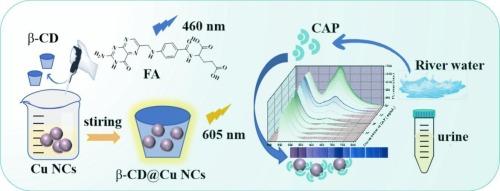Ratiometric fluorescence detection of captopril using folic acid-assisted β-cyclodextrin‑copper nanoclusters with smartphone-based visualization
IF 4.9
2区 化学
Q1 CHEMISTRY, ANALYTICAL
引用次数: 0
Abstract
The development of sensitive and selective detection methods for captopril (CAP), a widely used antihypertensive drug with potential environmental and health risks, remains an important challenge. In this work, we present a novel ratiometric fluorescence sensor based on folic acid (FA)-assisted β-cyclodextrin-coated copper nanoclusters (FA-Cu NCs@β-CD) for rapid CAP detection. The fluorescence of the Cu NCs capped with 2-mercaptobenzimidazole-5-sulfonic acid sodium salt (MBZS) was weak, but its intensity increased significantly upon encapsulation by β-CD, which is consistent with the mechanism of aggregation-induced emission (AIE). The addition of blue-emitting FA yielded a dual-emission fluorescent probe. CAP detection was achieved through its specific affinity for copper, which disrupted the structure of the Cu NCs, leading to quenching of the orange emission (605 nm) while maintaining the stability of the blue fluorescence (460 nm) of FA. The method exhibited a wide linear detection range (0.25–40 μg/mL) and a low limit of detection (61 ng/mL). The system demonstrated excellent selectivity against interfering substances and was successfully applied to detect CAP in river water and human urine samples, with good recoveries (97.5–107.0 %). Notably, the distinct color change from pink to blue after adding CAP allowed for smartphone-based visual quantification, demonstrating significant potential for onsite monitoring. This work provides a simple, cost-effective, and reliable approach for CAP detection that combines the advantages of ratiometric fluorescence with portable visualization.

基于智能手机可视化的叶酸辅助β-环糊精-铜纳米团簇比率荧光检测卡托普利
卡托普利(captopril, CAP)是一种广泛使用的具有潜在环境和健康风险的降压药,开发敏感和选择性的检测方法仍然是一项重要的挑战。在这项工作中,我们提出了一种基于叶酸(FA)辅助β-环糊精包覆铜纳米团簇(FA- cu nccs @β- cd)的新型比率荧光传感器,用于快速检测CAP。以2-巯基苯并咪唑-5-磺酸钠盐(MBZS)包封的Cu NCs荧光较弱,但经β-CD包封后其荧光强度显著增强,符合聚集诱导发射(AIE)机制。添加蓝色发射FA产生双发射荧光探针。CAP检测是通过其对铜的特殊亲和力来实现的,这种亲和力破坏了Cu nc的结构,导致FA的橙色荧光(605 nm)猝灭,同时保持了蓝色荧光(460 nm)的稳定性。该方法线性范围宽(0.25 ~ 40 μg/mL),检出限低(61 ng/mL)。该系统对干扰物质具有良好的选择性,并成功地用于检测河流水和人尿样品中的CAP,回收率为97.5 ~ 107.0%。值得注意的是,在添加CAP后,颜色从粉红色变为蓝色,这使得基于智能手机的视觉量化成为可能,显示出现场监测的巨大潜力。这项工作为CAP检测提供了一种简单、经济、可靠的方法,结合了比例荧光和便携式可视化的优点。
本文章由计算机程序翻译,如有差异,请以英文原文为准。
求助全文
约1分钟内获得全文
求助全文
来源期刊

Microchemical Journal
化学-分析化学
CiteScore
8.70
自引率
8.30%
发文量
1131
审稿时长
1.9 months
期刊介绍:
The Microchemical Journal is a peer reviewed journal devoted to all aspects and phases of analytical chemistry and chemical analysis. The Microchemical Journal publishes articles which are at the forefront of modern analytical chemistry and cover innovations in the techniques to the finest possible limits. This includes fundamental aspects, instrumentation, new developments, innovative and novel methods and applications including environmental and clinical field.
Traditional classical analytical methods such as spectrophotometry and titrimetry as well as established instrumentation methods such as flame and graphite furnace atomic absorption spectrometry, gas chromatography, and modified glassy or carbon electrode electrochemical methods will be considered, provided they show significant improvements and novelty compared to the established methods.
 求助内容:
求助内容: 应助结果提醒方式:
应助结果提醒方式:


